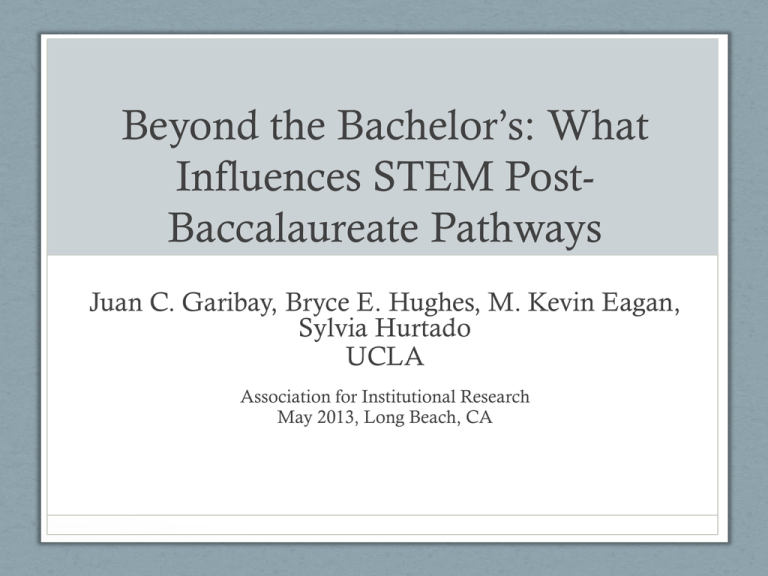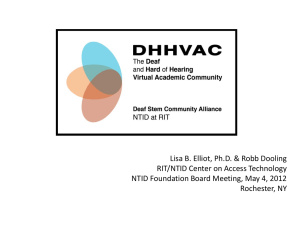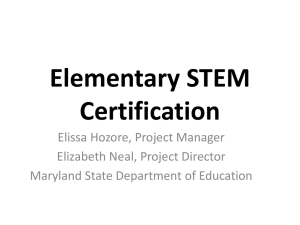Beyond the Bachelor*s: What Influences STEM Post
advertisement

Beyond the Bachelor’s: What Influences STEM PostBaccalaureate Pathways Juan C. Garibay, Bryce E. Hughes, M. Kevin Eagan, Sylvia Hurtado UCLA Association for Institutional Research May 2013, Long Beach, CA A National Imperative • United States faces a critical shortage in its STEM workforce • STEM degrees constitute small proportion of overall bachelor’s degrees awarded • PCAST has called for an additional one million STEM degrees over the next decade • Yet amount of people with STEM degrees far outnumbers STEM workforce • Much remains unknown about turning STEM degrees into STEM careers Literature Review • STEM pathways continue to be shaped by background, especially race/ethnicity and gender • High school academic preparation is also key; more math and science are crucial • Institutional context matters—graduates of elite institutions attend elite graduate institutions and take jobs related to their majors Literature Review • Key STEM experiences are structured to improve the retention and persistence of students in STEM fields • • • • • Undergraduate research programs STEM retention programs targeted to URM students Major-related clubs and professional associations Internships and cooperative experiences Faculty support and mentoring • Little is known about how these experiences affect post-college STEM trajectories Conceptual Framework • Career decision-making theory: • Harren, 1979 • Psychological factors associated with career decision-making • Emphasizes role of identity and background • Includes the role of developing purpose • Hodkinson & Sparkes, 1997 • Career decision-making is influenced by individual factors as well as social and cultural contexts • Opportunities are structured through accumulated capital and experiences, affecting a student’s available career alternatives Purpose • The purpose of this study then is to identify the student and institutional factors that associate with post-college STEM pathways seven years after college entry. • Specifically: • Which experiences lead students into the STEM workforce compared to STEM graduate programs? • Which experiences divert STEM talent into non-STEM alternatives? Methods: Data Source and Sample • Data sources: • 2004 CIRP Freshman Survey • 2011 Post-Baccalaureate Survey • Integrated Postsecondary Education Data System (IPEDS) • Sample size: • 7,331 STEM bachelor’s recipients who attended 471 institutions • Analysis • Descriptive statistics • Multinomial HGLM Methods: Dependent variable • Status in terms of employment or matriculation into graduate school • Have enrolled in STEM graduate program • Are employed in STEM career (and have not enrolled in a graduate program) • Have departed from STEM pathway (non-STEM graduate program or career) Methods: Independent Variables • Student-level: • Pre-college: • • • • Demographic characteristics Prior academic preparation Educational and career aspirations Pre-college experiences • During college: • Self-perceptions, aspirations, and goals • Undergraduate STEM-related experiences • Institution-level: • Selectivity, minority-serving institution, size, control Descriptive Statistics Dependent Variable Percent Has Enrolled in a STEM grad program 31.2 STEM workforce & no grad school 31.3 Departure from STEM pathway 37.4 Demographics Gender: Female 48.7 American Indian 3.3 Asian/Pacific Islander 12.2 Black 11.8 Latino/a 10.5 Other race 1.6 White 60.6 Findings: Enrollment in a STEM Grad Program vs. STEM workforce Significant Predictors of STEM Grad Program Sign Background/Precollege Characteristics Socioeconomic Status + Native English Speaker -- HS GPA + SAT score + Degree Aspirations: Master’s (ref. other degree aspirations) + Degree Asp: Health Prof. Degree (M.D., DVM, DOO, etc.) + Degree Asp: Ph.D./Ed.D. + Career Asp: Engineer (ref. all other careers) -- Findings: Enrollment in a STEM Grad Program vs. STEM workforce Significant Predictors of STEM Grad Program Sign Undergraduate Experiences Undergrad Major: Engineering (Ref. Bio Sciences) -- Undergrad Major: Health Professional (Ref. Bio Sciences) -- Undergrad Major: Math/Stats (Ref. Bio Sciences) + Undergrad Major: Comp/Tech Sciences (Ref. Bio Sciences) -- Work w/ faculty member on her/his research + Receive mentoring from faculty member + Participate in academic club or professional organization + Work off campus during academic year -- Findings for Enrollment in a STEM Grad Program vs. Non-STEM Path Significant Predictors of STEM Grad Program Sign Background/Precollege Characteristics Gender: Female -- HS GPA + SAT score + Social Self-Concept -- Degree Asp: Health Prof. Degree (M.D., DVM, DOO, etc.) + Career Asp: Engineer (ref. all other careers) + Career Asp: Scientific Researcher (ref. all other careers) + Career Asp: Computer Programmer (ref. all other careers) + Career Asp: Health Prof. (ref. all other careers) + Goal: Becoming successful in a business of my own -- Findings for Enrollment in a STEM Grad Program vs. Non-STEM Path Significant Predictors of STEM Grad Program Sign Undergraduate Experiences Undergrad Major: Health Prof. (Ref. Bio Sciences) + Undergrad Major: Math/Stats (Ref. Bio Sciences) -- Undergrad Major: Computer/Tech Sciences (Ref. Bio Sciences) -- Work w/ faculty member on her/his research + Receive mentoring from faculty member + Participate in an academic club or org. + Work off campus during the academic year -- Institutional Characteristic Control: Private + Discussion • Gender disparities in departure • Socioeconomic differences also salient • Students from higher socioeconomic backgrounds more likely to enter STEM graduate training as opposed to STEM workforce • Students who worked off campus during the academic year were more likely to forego STEM graduate training and go into the STEM workforce or into non-STEM pathways • Prior academic preparation continues to influence postbaccalaureate decisions Discussion • Connections w/ faculty are critical in the decision to pursue a STEM graduate degree • Mentorship • Working on professor’s research • Informal networks like student clubs also exhibit a peer influence on post-baccalaureate decisions • Different STEM careers require different educational credentials for entry and thus different post-baccalaureate pathways • Institutional context did not play as significant a role as expected • Data limitations may have masked some of these effects • May play an indirect role • May have conditional effects Implications • Retaining STEM talent in post-undergraduate years • Graduate admissions requirements and structures • Financial difficulties may be impeding the ability of many students to pursue their STEM ambitions • Faculty are crucial in encouraging students to seek scientific research careers by providing opportunities to engage in research and insights into what a research career entails • STEM fields also have a diverse array of credential requirements for entry; further analysis by field can highlight the diversity of pathways into each field Thank you! Contact Us Faculty/Co-PIs: Sylvia Hurtado Mitchell Chang Kevin Eagan Postdoctoral Scholars: Josephine Gasiewski Administrative Staff: Dominique Harrison Graduate Research Assistants: Tanya Figueroa Gina Garcia Juan Garibay Bryce Hughes Papers and reports are available for download from project website: http://heri.ucla.edu/nih Project e-mail: herinih@ucla.edu This study was made possible by the support of the National Institute of General Medical Sciences, NIH Grant Numbers 1 R01 GMO71968-01 and R01 GMO71968-05, the National Science Foundation, NSF Grant Number 0757076, and the American Recovery and Reinvestment Act of 2009 through the National Institute of General Medical Sciences, NIH Grant 1RC1GM09077601. This independent research and the views expressed here do not indicate endorsement by the sponsors.








